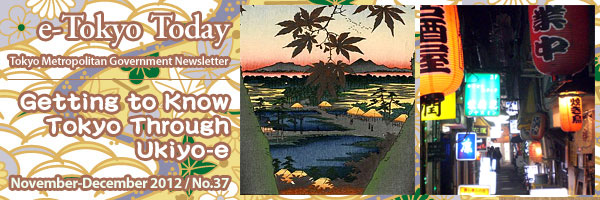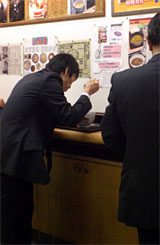
 |
|
News & Announcements |
|||
|
Q-pot CAFE. : Mysterious Candy House opened in Omotesando
The cafe itself is just like a candy house we used to imagine when little. There's a biscuit room, a chocolate room...and "seQret" room. While offering set menus in the cafe and some take-away options, they also have full course of sweets (on a reservation basis only) in the hidden room, somewhere in the cafe. See and enjoy the edible accessories just like enjoying fashion! Q-pot CAFE. |
|||
|
TOKYO YOKOCHO Week: great night out option for this winter
Yokocho literally means "alleyways off the main street" and includes the small pubs and bars that are found on these narrow streets, and we enjoy "yokocho" doing "hashigo" from one bar to another. The campaign is held at the yokocho called Yurakucho Sanchoku Inshokugai. During the period from January 15 through March 15, 2013, get a free giveaway upon the completion of the questionnaire and 2 bar hoppings. Those who post photos at yokocho or other nightlife spots to our "Tokyo Fan Club" page by February 15 can receive lucky prizes, like limited Tokyo goods and traveling gear. English menus? No problem. To get to know yokocho better, please check our website. GOTOKYO (details on the campaign available from December 10) |
|||
|
Toyokan (Oriental Art Hall) of Tokyo National Museum Reopens
Tokyo National Museum |
|||
|
Tokyo City Promotion in Germany
http://www.promotion-tokyo2013.com (German only) |
|||
|
Getting to Know Tokyo Through Ukiyo-e |
|||||||||||||||||||||||||||
|
Ukiyo-e and Edo
Utamaro, Sharaku, Hokusai, and Hiroshige... If you are familiar with these names, you are a real Japan expert. They are the big names in the world of ukiyo-e of the Edo period (1603-1867).Ukiyo-e, Japanese woodblock prints, are a representative art of Japanese traditional culture that is considered to be a catalyst of the "Japonism" that largely influenced Western arts, mainly inspiring many European impressionist painters. However, ukiyo-e originally served as media, too, that reported all kinds of information to the urban residents of Edo times, rather than as a fine art to be appreciated as such. People were able to get information about trendy spots, favorite kabuki actors, and popular places to visit in Edo (current Tokyo), through ukiyo-e. Let’s go into the world of ukiyo-e! (Click the ukiyo-e below to enlarge) Popular Sightseeing Places depicted in Ukiyo-e
Even in Tokyo, an ever-changing metropolitan city, there remain some things that are unchanged. Here are some of these places, which used to be and still are popular places to visit among locals and tourists, and appear in ukiyo-e.
The large lantern at the Kaminari-mon gate in the front and the approach stretching to Senso-ji Temple and its five-storied pagoda are seen in the block print. By the way, do you notice the difference on the lantern between past and present? The actual lantern at the Kaminari-mon is marked as "雷門" (kaminarimon). Meanwhile, the lantern in the ukiyo-e is marked as "志ん橋" (shimbashi), which was dedicated by an association of Japanese restaurants and geishas in Shimbashi, one of the entertainment districts in Edo. Now, the lantern with "shimbashi" is hung at the main building of the temple instead. Map Senso-ji
The town was named after Suruga-no-kuni (Suruga domain, current Shizuoka Prefecture). Known as the birthplace of the first Shogun in the Edo period, Tokugawa Ieyasu, as well as the area where Mount Fuji is located, Suruga domain was a special location for many Japanese. Echigoya was established by a talented merchant, Mitsui Takatoshi. He opened a shop selling kimono and dealing with money exchange in Edo. He pioneered a series of new business methods, including a cash sale system instead of the traditional credit system. He moved the shop to Surugacho in 1681, and it became the Shogunate’s designated kimono store as well as an official government bank. Wide Perspective View of the Interior of Echigoya in Surugacho tells us much about the great success of Echigoya. In Hokusai’s woodblock print, you can tell it is the New Year holiday by the kites in the sky. People working on the roof seem to be tilers. Map Mitsukoshi
There are many Tenman-gu in Japan, with all of them enshrining Michizane. While most of them are famous for plum blossoms, the flower he loved most, Kameido Tenjin, has been famous as Japanese wisteria blossom since the Edo period. Go on the Taikobashi Bridge, and you can look down on a carpet of beautiful wisteria on the trellises in late April to early May. The woodblock print depicts the Taikobashi Bridge, wisteria blossoms surrounding the pond, and people enjoying the blossoms under the trellises just as we do with cherry blossoms. There used to be tearooms and sake-serving restaurants in the precincts, and now there are old-style high-class Japanese restaurants around the shrine in a well-preserved Edo atmosphere. Map Kameido Tenjin Festivals in Ukiyo-e
Sanno Matsuri These shrines were regarded as the dwelling of the tutelary deity of the Tokugawa Shogun family and the guardian deity of Edo, respectively, so it was natural they were so much respected and worshipped, and their annual festivals were called Tenka Matsuri (Shogun’s festivals) and their floats were allowed to enter Edo castle and received in audience by the Shogun. We can see floats in these two ukiyo-e woodblock prints. Flags held by people in "Sanno Matsuri from Edo Meisho" tell you that they belonged to Koji-machi, one of the shrine’s parish towns. It is said that each parish town had its own float. Sumo
This piece can tell a lot about difference and similarity between today’s sumo and that of the Edo period. It depicts dohyo-iri ("entering the ring"), a ceremony to introduce sumo wrestlers before top division bouts. Wrestlers on the left side (Western side) were about to mount the ring while the Eastern side wrestlers had just finished the ceremony. Today dohyo-iri is still held in a simplified manner. In the Edo period, sumo was held outside because there was no particular stadium, and mostly held at Eko-in Temple. The four pillars of the ring represent the Four Symbols of the four mythological creatures of the four directions (north, south, east and west). In the current Grand Sumo Tournaments held six times a year, the pillars are replaced by tassels that have been hung from the ceiling since 1952. But the biggest difference was that only men were allowed to be in the audience for kanjin sumo. However, the gallant appearance of popular sumo wrestlers gathering at the dohyo-iri ceremony surrounded by a huge audience remains the same. Grand Sumo Where to Appreciate and Buy Ukiyo-e
Places to Appreciate Ukiyo-e Tokyo National Museum Ukiyo-e Ota Memorial Museum of Art Sumo Museum Due to changing of displays that takes place six times a year, there may be no display of ukiyo-e during some periods. Ukiyo-e of the end of the Edo period will be exhibited from October 23 through December 24, 2012. Places to Buy Ukiyo-e Original Ukiyoe Gallery Toshusai Ohya Shobo Book Store Mita Arts Gallery Shukado The Adachi Institute of Woodcut Prints: The company has a showroom as well as a studio, and sells reprints of ukiyo-e. |
|||||||||||||||||||||||||||
Useful Tips for Having Fun in Tokyo on a Budget: Noodle Stand |
 If you find a shop where people slurp noodles while standing, it's "tachigui soba-ya," standing noodle stand. If you find a shop where people slurp noodles while standing, it's "tachigui soba-ya," standing noodle stand.This kind of noodle shops is commonly in and around train stations and office districts, and serves buckwheat noodles and udon noodles. As a Japanese version of fast food shops, they are convenient for travelers to get a quick meal at an affordable price - often less than 300 yen (US$ 3.75). Most shops use a self-service style. Buy tickets at the vending machine, which is usually set up at the entrance, hand them to the staff, and wait for a while near the counter, with a number plate at some shops. Try and experience tachigui soba-ya! |
Event Information |
|||
Kanda Matsuri
On May 11, a splendid procession of about 2,000 people will parade through central Tokyo including Kanda, Nihombashi, Marunouchi, and Akihabara. On the 12th, about 100 miniature shrines will be carried into the shrine one after the other from morning to evening as the festival’s dramatic climax. Access: 5 min from Ochanomizu Station on the JR Chuo/Sobu lines or Tokyo Metro Marunouchi Line, 5 min from Shin-Ochanomizu Station on the Tokyo Metro Chiyoda Line, 7 min from Akihabara Station on the JR Yamanote and Keihin Tohoku lines or Tokyo Metro Hibiya Line, or 5 min from Suehirocho Station on the Tokyo Metro Ginza Line on foot. Map Kanda Myojin Shrine (Japanese only) |
|||
Sanno Matsuri
Access: 5 min from Kokkai-gijidomae Station on the Tokyo Metro Chiyoda Line, or 3 min from Tameike-sannno Station on the Tokyo Metro Ginza and Namboku lines on foot. Map Hie Shrine |
|||
|
No Negative Impact on Our Health: Updated Radiation-related Information in Tokyo
|
|
Radiation dose after touring Tokyo for one day (July 9, 2012) Report on field measurements (Japan Tourism Agency)
According to the survey on radioactivity in Tokyo conducted by the Japanese Tourism Agency, the measured air dose was below the global average. Radiation dose after touring Tokyo for one day (July 9, 2012) Report on field measurements Radiation Level in the Air (Tokyo Metropolitan Institute of Public Health) Environmental radiation levels in Tokyo Radiation Level in Tap Water (Bureau of Waterworks Tokyo Metropolitan Government) No radioactive substances have been detected either from raw water or at the water purification plants of Tokyo since April 2011. Latest information related to the effect on purified water by radioactivity List of banned foods and shipping restrictions Food products are monitored every day for radioactive materials. The Japanese government restricts distribution and consumption of food products containing any level of radiation that exceeds the regulatory standards. Ministry of Health, Labour and Welfare: Information on the Great East Japan Earthquake Q&A on Foods and Fishery products Ministry of Agriculture, Forestry and Fisheries: FAQ on mushrooms, edible wild plants, rice, milk, dairy products, meat and eggs (as of June 13, 2012) Fisheries Agency: Questions and answers on fishery products |